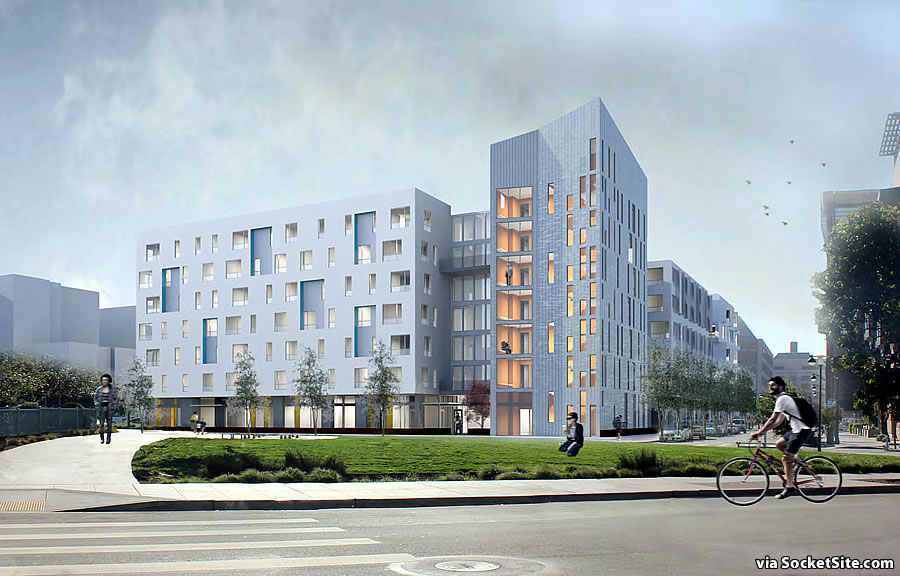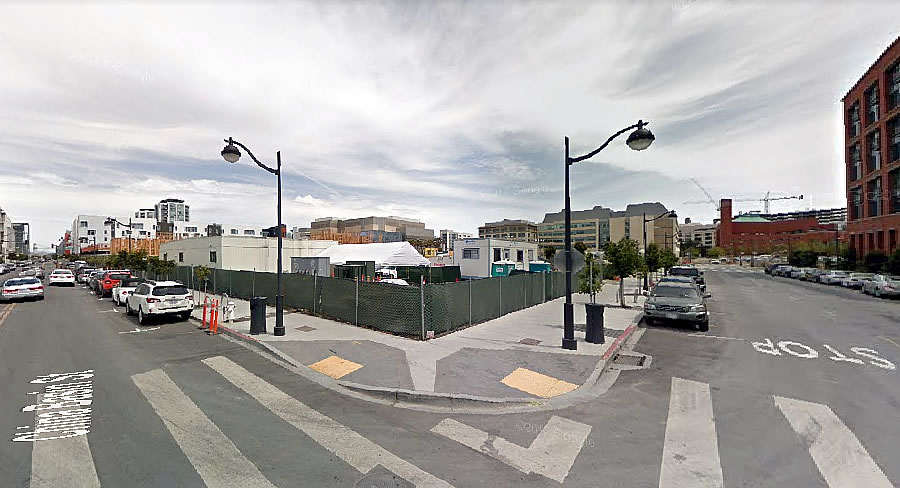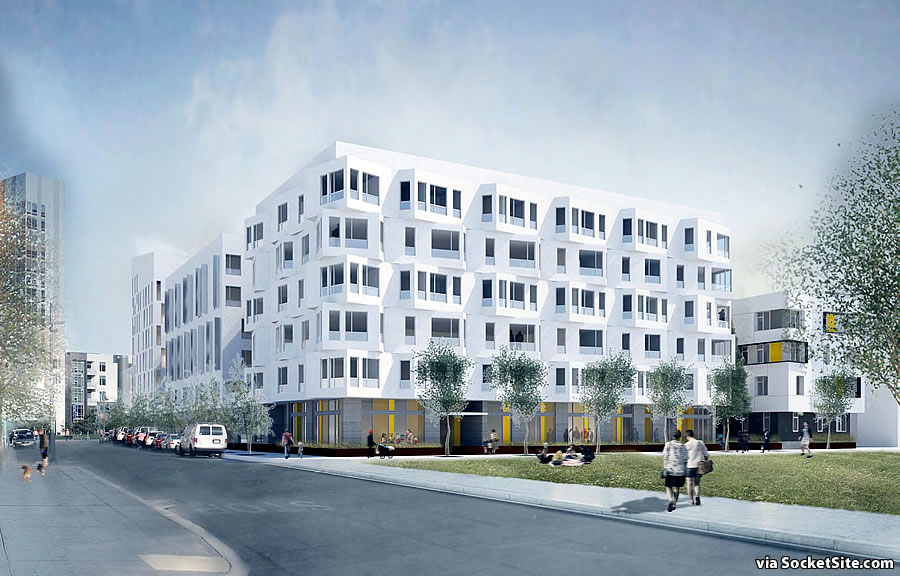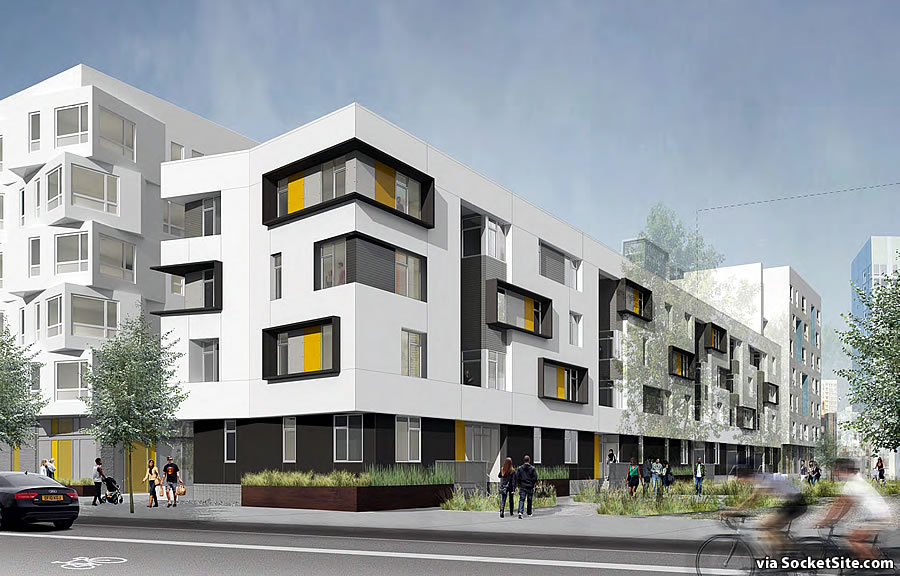As designed by Paulett Taggart Architects and Studio Vara for Mercy Housing, the proposed development to rise up to 74 feet in height, not including its parapets, on the western half of Mission Bay South Block 6, along Merrimac Street, between China Basin and Mission Bay Boulevard North, will yield 152 units of affordable housing for low-income families, including 38 apartments which are to be set aside for households relocating from HOPE SF public housing sites which are to be redeveloped.
The project’s proposed mass has been broken down into four distinct “wings,” the tallest of which would front China Basin Street and overlook the new Mission Bay Kids’ Park, with a childcare center for around 45 kids on the ground floor.
The wing fronting Mission Bay Boulevard, which would overlook the future Mission Bay Commons, features a series of angled bays designed to create “a serrated ribbon effect” and a ground floor arts and activities space which is slated to be leased to Blue Bear School of Music.
And a four-story wing with stacked flats and stoops would line a mid-block pedestrian mews.
The 152 apartments, over 70 percent of which will have at least two bedrooms, will be made available to households making up to 60 percent of the Area Median Income (AMI).
The development also includes a 28-space garage with its entrance on Merrimac, with a parking ratio of 0.2 spaces per unit which is intended “to balance parking availability and project financial feasibility.”
And assuming the plans for Mission Bay South Block 6W are approved as proposed, Mercy is planning to apply for financing by the end of the year and start construction in the first half of 2019, finishing in mid-2021. We’ll keep you posted and plugged-in.




Nice example of how a project can be simple, contemporary, and elegant within budgetary constraints. This sector (low-income/affordable) has come so far in the last generation in terms of design.
This looks great! Designers: look.
Nice, it’s gorgeous. Meanwhile the subsidized affordable project on the east half of this block appears to be wrapping up construction.
As a Mission resident I’m kinda jealous that Mission Bay’s subsidized affordable housing is moving forward while all the proposals in the Mission continue to be stalled. Would love to see motion on any of ours, especially on the blighted former gas station site at 16th/South Van Ness.
The original private developer for that site was just about to finally break ground a couple of years ago when the City got the bright idea to acquire it (at an exorbitant price) to build 100% “affordable” housing. The limited funds available would have been better applied elsewhere and that blighted corner would now be occupied by happy residents who displaced nobody.
I too have doubts about the wisdom of that purchase, but what’s done is done. We do need affordable housing. So at this point I just want it built.
Mission Bay doesn’t have a shake-down racket MEDA fighting everything they want to put up. I have personally heard, straight from their mouths, that they don’t care what is built in Mission Bay, “build all the market-rate housing you want there!”
Good design. Could have been taller to accommodate more people
7 stories in the front? That’s pretty good considering Mission Bay is basically built on jello pudding. I’m sure going up higher costs a lot more. Keep it affordable and get it done asap. Build higher in the places with real bedrock. We don’t need any more Millennium towers.
Are you saying 7-story buildings are immune to liquefaction?
Many much taller buildings downtown are built on landfill and are on friction.piles that don’t go down to bedrock, and they survived Loma Prieta and aren’t leaning.
Sure. Many much taller buildings downtown are built on landfill – and they cost a lot more more per square foot. A lot more. Like double. Hence not affordable. And since the point here is affordable housing – yours is not really germane to the point I was making is it?
Of course not. Nothing is immune to liquefaction. Magic isn’t real – science is. The building is subject to liquefaction – but 7 story buildings that are wider than they are tall are not likely to fall over on other people like the Millenium tower could in a giant earthquake now are they? Nope.
A seven story building that sinks a couple of feet down – but stays together – is not really a disaster for the City. A 58 story 645 foot tall skyscraper downtown – that falls over into its neighbors is a disaster for the City. And until the lawyers quit jabbering about money and the other associated weasels quit trying to assign the blame to each other – and the contractors pour concrete to fix it – people are at risk.
Pretty sure they accounted for and/or altered the density of the land in Mission Bay. It’s not a difficult task.
Hmmm… Of course if you actually go this building site – they have had over a foot of differential settlement between the outside sidewalks and the adjacent building entrances. But if your pretty sure it’s all ok maybe the lawyers can all just go home…
We’ve had really tall public housing buildings before. They were in Visitation Valley and they were not a good idea.
Oh, and I love that so much this is 2+ bedrooms.
Public Housing and Affordable Housing are very different. None of the affordable housing in Mission Bay is government owned/government run, and is mostly oriented towards working families (60% of median income is still a lot of money), rather than the poorest of the poor. There’s no reason that towers wouldn’t work for affordable housing.
Want to make housing more affordable? New Zealand’s Minister Jacinda Ardern announced a ban on foreign buyers last week. “We are determined to make it easier for Kiwis to buy their first home, so we are stopping foreign speculators buying houses and driving up prices. Kiwis should not be outbid like this.” If you want to do even one better, ban institutional ownership up to four units.
The reality is that our leaders do not want to make housing more affordable. They want real estate prices to the moon, and they want to make up the difference with handouts for the poor. The middle class picks up the bill, as usual.
Agree – the middle class picks up most of the bill; the same people that put those leaders in place. The rich 1% is only one percent; most of the poor don’t vote, leaving the middle class to elect leaders…
All but the highest income brackets have around 50-75% of their net worth tied up in home equity. If home prices became more affordable, that would be a huge blow to the Fed wealth effect and credit ponzi. So home prices here will never become more affordable via government policy, only through forces outside their control.
wouldn’t banning foreign buyers be a government policy?
Very smart observation, but I am not decrying government policy here, I am only stating which government policy is likely to occur in the US, and why.
Maybe in SF, the rich liberals are not pro-development. Everywhere else people are pro-development especially the poor.
Higher property values translates to higher tax revenues to feed over bloated government payroll and benefits. Reduce the size of government first.
NZ is an entirely different geographic and economic animal. It is doubtful banning foreign sales would make much of a dent here. A recession usually takes care of housing shortages here.
Not sure what this has to do with the article — we’re not talking about market-rate housing here. But since you brought it up, this meme about foreign buyers being the culprit is xenophobic trash. Plenty of the biggest speculators are based right here in SF—look up where Veritas is headquartered. And what makes speculation so appealing is our extreme scarcity of housing, which is due to the insistence on low-density zoning and a NIMBY-friendly process with maximum opportunities for delay, which again is the product of busybody neighbors right here in SF.
It has to do with the article because there are different ways to handle the goal of “affordable” housing. The current way is to screw the middle class twice, once by taking away what could have been market rate housing supply that would theoretically bring prices down for them, and two by taxing them for whatever various costs the public may incur with subsidized housing. Another way would be to go after the demand side by giving regular citizens priority over foreign or institutional investors, and still another would be to address the loose lending practices that invariably drives prices higher, and that are once again backstopped by the middle class taxpayer.
Anyone who thinks foreign investors haven’t affected CA RE prices has their head buried DEEP in the sand. It’s not just the sheer numbers, but also the willingness to offer way above asking price due to their atypical motivation. Just ask any local agent if they haven’t had an offer beat out by a foreign buyer. And if you go to San Marino, one of the most expensive addresses in California, you can see the real estate signs are often in foreign script.
This has nothing to do with xenophobia by the way, I am foreign born myself. Not to mention, many other countries including China, Mexico, Australia, Switzerland, Singapore, Hong Kong, and Canada have limits or taxes on foreign buyers.
Banning foreign buyers would have to be a federal policy due to the Constitution’s Commerce Clause. You will never see that happen with the current Congress or President.
Why do they build all affordable housing units in Mission Bay? Why don’t they build Affordable Housing in other neighborhoods such as Pacific Heights? Mission Bay is overcrowded with Affordable Housing units. It is unfair to Mission bay residents. On top of it they will move people from Hope SF public housing sites to Mission Bay across from a Children’s Park and Day care center…
Why is building affordable housing “unfair” to Mission Bay residents? And where would you propose The City build affordable housing in Pacific Heights?
Children growing up in public housing deserve access to daycare and parks too.
Note the assumption that HOPE SF residents are too unsavory to be next to a playground. Sarah, you need to examine your biases.
There is so much affordable housing in Mission Bay because the City (Redevelopment Agency) took upon many of the costs of providing the public infrastructure (sewers, roads, etc), and zoned in a requirement for much of the housing (30%? I forget the exact number) to be affordable. This is a completely fair deal.
Because the “market” was significantly more robust than expected, virtually all of the market rate housing is now built or under construction. All of the remaining housing sites will be affordable.
Dude — Sunnydale (aka “Hope”) makes Bayview Hunters Point and the 6th Street corridor both look like a resorts. If you live in the neighborhood, hope you don’t park on the street….let alone walk on the street after dark…
This is beautiful, targets an important segment at < 60% AMI, and has a reasonable parking ratio for its location. Thanks for this news.
Sorry people, although nice project, this is not a budget project. Rotating facades are not budget facades, nor recessed openings which require double wall construction. Metal eyebrows are nice but come at cost premiums. Often times more money per square feet is spent on affordable housing than market rate.
That being said, it’s nevertheless welcome addition.
UPDATE: Timing and Cost of Affordable Family Housing to Rise in Mission Bay